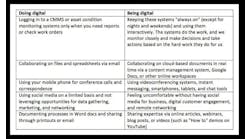By Christine Radke, digital officer at Siemens
In a world where almost everything is available on-demand, the customer experience is more important than ever. This is evident across consumer markets, but it should be no difference in the B2B manufacturing space. On the surface, it’s relatively simple: with an elevated experience, businesses—in this case, manufacturers—give their customers what they want when they want it, creating a seamless experience across channels that streamlines the sales process and results in happier customers.
Of course, this simple idea can be much tough to execute in practice. Transactions with manufacturers are typically laborious and time-consuming back-and-forth affairs. And the challenges ramp up exponentially as more moving parts are introduced, both literally and figuratively.
It’s not easy, but one way for manufacturers to do this successfully is to improve their digital-sales process. There are five major keys to transforming digital sales that can help manufacturers of all types meet their corporate goals:
1. Make the configuration process a welcome entry point. The first thing manufacturers need to do is examine what is happening in their customers’ specific market. What is their issue? What do they want to do? With so many parties involved in the process—sales teams, engineers, product managers and, most importantly, end customers—a Configure Price Quote (CPQ) tool that empowers productivity for each of these stakeholders is vitally important.
For me, that’s why “C”—configuration—is the most important component of CPQ, particularly for manufacturers that offer a wide variety of products, each with multiple customizable options. A modern configurator allows the end customer to visualize and adjust their products in real-time, and augmented reality enables them to see what it would look like in their actual physical setting, whether it’s a piece of machinery on a factory floor or a medical device in a clinical setting.
This enhanced customer experience is valuable, but it is only one benefit of using an innovative configuration system. Since this approach captures data in real-time, it keeps everyone along the chain constantly updated with accurate information, allowing for smoother and more transparent communication and the ability to pivot quickly if and when any changes suddenly occur.
2. Utilize seamless data and replicable data models. When it comes to product-data entry, repeatable data models are invaluable. At the very basic level, it saves time because it prevents teams from having to manually enter the same data over and over again. But product data should also be seamless and flow throughout the entire manufacturing organization so it can be used as a core source for product models.
This approach should be applied not only to one product or one product group; it should be a core structure for all product portfolios. It allows for different views from various research and development engineers or product-lifecycle management teams in an easy-to-find data set that can be handled afterward by any other parties that may be involved.
3. Provide customers with quotes as quickly as possible. In manufacturing, there can be a lot of back-and-forth discussion and negotiation before the customer is even offered an initial quote. Some of this may be necessary to offer the most accurate quote possible, but a lot can change during that time, which can displease the buyer and lead to lost sales.
Modern CPQ systems can essentially offer quotes to customers in real-time while they make adjustments to the products they design. Truly final quotes could change based on factors such as volume, but giving customers instant access to a ballpark figure can go a long way toward gauging their true interest and ultimately closing deals.
4. Use systems that accelerate transfer of order. Completing the journey of the manufacturing process is transferring the necessary components to the factory. Is what the customer configured producible and manufacturable? If the previously mentioned factors such as seamless and replicable data have been addressed, then the answer should undoubtedly be yes.
But if and when there are changes after the initial order—and as any manufacturer knows, there are often quite a lot of changes—what you configure should still be manufacturable and produced in the production line that is set up. Allowing internal operations to receive the right data in a way that allows them to truly focus their energy on the manufacturing process is something that is vital to have in place.
5. When possible, future-proof your operations. For many manufacturers, technology has evolved at a rate that has eclipsed their capabilities and negatively impacted their ability to meet demand. This is why we hear so many talk about the ever-elusive "digital transformation."
When it comes to manufacturing, this notion means investing in software and systems that are "future-proof," or have the ability to continuously improve as innovation and market conditions dictate. Make no mistake—this type of digital transformation doesn't happen overnight. True digital transformation not only requires upgraded technology, but also organization-wide buy-in to systems and processes that will need to change to improve; this may, initially, seem foreign to team members.
All of that said, digitally transforming the sales process is a worthwhile investment and time commitment for today’s manufacturers. Those who do so in a way that breeds commitment to a superior experience for their end customers stand to gain a competitive advantage that will help them meet their larger corporate goals.
